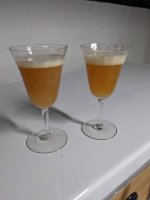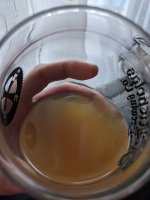Belgian Samurai
Well-Known Member
- Joined
- Dec 15, 2020
- Messages
- 112
- Reaction score
- 33
haha Hi. So, I brewed the world's ugliest beer. Let's talk about it! 
The recipe is a Belgian citrus wheat ale. Having recently finished my keezer build, buying a new kettle and moving from LME kits to BIAB recipes, I wanted to do a all-grain recipe. Now, I found the conversion for LME to DME, as I also did not want to pour LME into my BIAB bag. I thought it would work just fine from what I read about LME vs DME.
Ingredients
5.5 lbs. Wheat DME (No, that is not a typo.)
1 lb. Two-Row Brewers Malt
1 lb. White Wheat Malt
.75 lb. Flaked Oats
1 oz. Hallertau hops (3.9 AAUs) @ :60
7 oz. Roasted coconut @ :20
4 oz. dried orange peel @ :10 (post-further research, i'll use fresh zested oranges next time.)
3 tsp. fresh ground coriander @ :10
S-33 Belgian ale yeast
I have not tasted it yet. What do you think it will taste like? It's been about 5wks. The following image was taken today.
Belgian Samurai

The recipe is a Belgian citrus wheat ale. Having recently finished my keezer build, buying a new kettle and moving from LME kits to BIAB recipes, I wanted to do a all-grain recipe. Now, I found the conversion for LME to DME, as I also did not want to pour LME into my BIAB bag. I thought it would work just fine from what I read about LME vs DME.
Ingredients
5.5 lbs. Wheat DME (No, that is not a typo.)
1 lb. Two-Row Brewers Malt
1 lb. White Wheat Malt
.75 lb. Flaked Oats
1 oz. Hallertau hops (3.9 AAUs) @ :60
7 oz. Roasted coconut @ :20
4 oz. dried orange peel @ :10 (post-further research, i'll use fresh zested oranges next time.)
3 tsp. fresh ground coriander @ :10
S-33 Belgian ale yeast
I have not tasted it yet. What do you think it will taste like? It's been about 5wks. The following image was taken today.
Belgian Samurai

Last edited:





